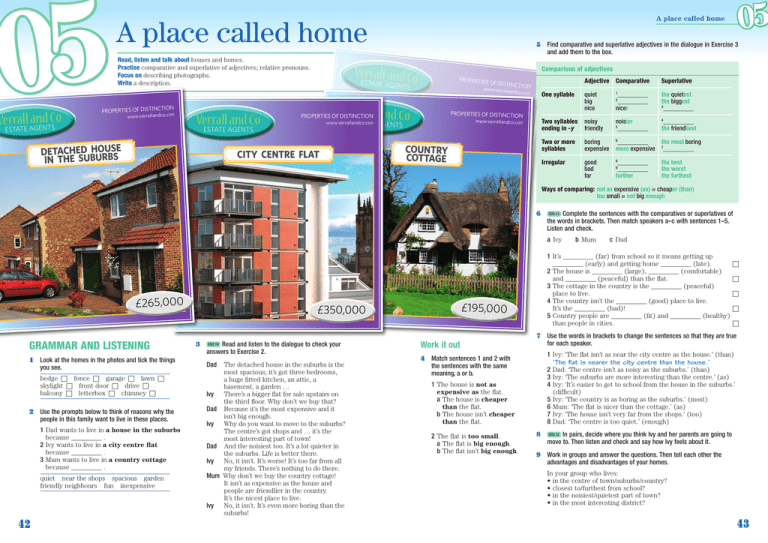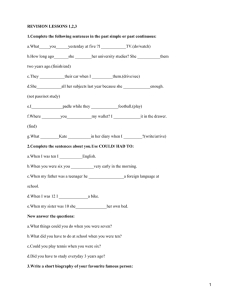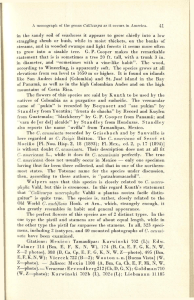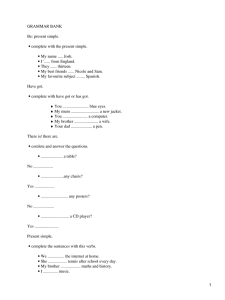A place called home
Anuncio

05 A place called home anENdTSCo VeESrrTAalTElAG Read, listen and talk about houses and homes. Practise comparative and superlative of adjectives; relative pronouns. Focus on describing photographs. Write a description. CTION PROPERTIES OF DISTIN www.verrallandco.con Verrall and Co ESTATE AGENTS DETACHED HOUSE IN THE SUBURBS 5 Find comparative and superlative adjectives in the dialogue in Exercise 3 and add them to the box. Comparison of adjectives Verrall and Co PROPERTIES OF DISTINC TION www ESTATE AGE NTS .verrallandco .con DETACHED PROPERTIES OF DISTINCTION Ve rra PROPERTIES OF DISTINCTION HOUSE ll an d INCo www.verrallandco.con ESTATE AGENTS THE SUBURBS www.verrallandco.con £265,000 CITY CENTRE FLAT 05 A place called home COUNTRY COTTAGE One syllable Adjective Comparative Superlative _________ _________ nicer the quietest the biggest quiet big nice 1 2 3 _________ 4 Two syllables noisy noisier _________ 5 ending in -y friendly _________ the friendliest 6 Two or more boring _________ the most boring syllables expensive more expensive 7_________ 8 Irregular good _________ the best 9 bad _________ the worst far further the furthest Ways of comparing:not as expensive (as) = cheaper (than) too small = not big enough 6 CD2.11 Complete the sentences with the comparatives or superlatives of the words in brackets. Then match speakers a–c with sentences 1–5. Listen and check. a Ivy b Mum c Dad 1It’s _________ (far) from school so it means getting up _________ (early) and getting home _________ (late). 2The house is _________ (large), _________ (comfortable) and _________ (peaceful) than the flat. 3The cottage in the country is the _________ (peaceful) place to live. 4The country isn’t the _________ (good) place to live. It’s the _________ (bad)! 5Country people are _________ (fit) and _________ (healthy) than people in cities. £265,000 £265,000 GRAMMAR AND LISTENING 1 Look at the homes in the photos and tick the things you see. hedge fence garage lawn skylight front door drive balcony letterbox chimney 2 Use the prompts below to think of reasons why the people in this family want to live in these places. 1Dad wants to live in a house in the suburbs because _________ . 2Ivy wants to live in a city centre flat because _________ . 3Mum wants to live in a country cottage because _________ . quiet near the shops spacious garden friendly neighbours fun inexpensive 42 £195,000 £350,000 3 Read and listen to the dialogue to check your answers to Exercise 2. CD2.10 Dad The detached house in the suburbs is the most spacious; it’s got three bedrooms, a huge fitted kitchen, an attic, a basement, a garden … Ivy There’s a bigger flat for sale upstairs on the third floor. Why don’t we buy that? Dad Because it’s the most expensive and it isn’t big enough. Ivy Why do you want to move to the suburbs? The centre’s got shops and … it’s the most interesting part of town! Dad And the noisiest too. It’s a lot quieter in the suburbs. Life is better there. Ivy No, it isn’t. It’s worse! It’s too far from all my friends. There’s nothing to do there. Mum Why don’t we buy the country cottage! It isn’t as expensive as the house and people are friendlier in the country. It’s the nicest place to live. Ivy No, it isn’t. It’s even more boring than the suburbs! Work it out 7 Use the words in brackets to change the sentences so that they are true for each speaker. 1Ivy: ‘The flat isn’t as near the city centre as the house.’ (than) ‘The flat ¡s nearer the c¡ty centre than the house.’ 2Dad: ‘The centre isn’t as noisy as the suburbs.’ (than) 3Ivy: ‘The suburbs are more interesting than the centre.’ (as) 4Ivy: ‘It’s easier to get to school from the house in the suburbs.’ (difficult) 5Ivy: ‘The country is as boring as the suburbs.’ (most) 6Mum: ‘The flat is nicer than the cottage.’ (as) 7Ivy: ‘The house isn’t very far from the shops.’ (too) 8Dad: ‘The centre is too quiet.’ (enough) 4 Match sentences 1 and 2 with the sentences with the same meaning, a or b. 1The house is not as expensive as the flat. aThe house is cheaper than the flat. bThe house isn’t cheaper than the flat. 2The flat is too small. aThe flat is big enough. bThe flat isn’t big enough. 8 In pairs, decide where you think Ivy and her parents are going to move to. Then listen and check and say how Ivy feels about it. CD2.12 9 Work in groups and answer the questions. Then tell each other the advantages and disadvantages of your homes. In your group who lives: •in the centre of town/suburbs/country? •closest to/furthest from school? •in the noisiest/quietest part of town? •in the most interesting district? 43 new mes sage GRAMMAR AND READING 1 In pairs, look at the photo, read the email and answer questions 1–4. 1Where is Nadine staying in New York? 2What does she think of the district/her flatmate/the flat? 3What does Nadine find unusual about the flat? 4Why would you like/not like to live in this flat? to: [email protected] From: [email protected] Subject: USA trip day 8, New York City Hi Rosie Do you remember Miki? The Ame rican girl who we met at Joel’s part y? The girl whose father is a writer? I met her for a coffee yesterday and she invited me to spend a few days in her apa rtment! It’s on the Lower East Side – a great district where there are lots of coo l shops and cafés. Miki’s great – she’s just the kind of girl that you want to share a flat with and the flat is lovely. But there’s one thin g which is very odd about this plac e: there are glass walls between the different rooms! Everyone that see s it thinks it’s amazing and, obviously, it’s muc h better than the youth hostel whe re I was staying before. The thing that I like about it is the light: it’s so brig ht and cheerful! And there is an indoor gard en that is absolutely fantastic! But it’s strange living here. There are som e curtains but you can hear everyth ing that your flatmate does. And you know I’m not the kind of person who enjo ys that. I’m sending you a photo which I took this morning. Let me know wha t you think of it. Love, Nadine send 4 Choose the correct relative pronouns. Sometimes more than one answer is possible. Tick the sentences where you can leave out who, which or that. 1That’s the neighbour that / who / which lives upstairs. 2This is the key which / who / where you need to open the back door. 3This is a picture of the loft which / where / that I’m staying. 4This is the carpet that / which / whose I want to buy. 5That’s the man whose / who / that flat we’re renting. 6The guy which / whose / who you saw is my new flatmate. 7The flat that / which / whose we rented last year was very expensive. 5 Look at the email again and find five sentences with a relative pronoun you can leave out. 6 CD2.13 Listen and complete the plan of the flat where Nadine is staying. bathroom Nadine’s bedroom kitchen and dining room living room cupboard lavatory 7 Listen again and look at the plan. Write the numbers of the rooms where you can find these things. CD2.13 sink desk freezer shower armchair wardrobe washbasin bookshelves DVD player games console vacuum cleaner dishwasher 8 Write the missing relative pronouns. Then circle those which you can leave out. 1This is an apartment _________ owner is an artist. 2Do you see the computer _________ is on the desk? 3It’s one thing _________ I don’t like sharing. 4That’s the market _________ I do my shopping. 5The books belong to the girl _________ used to live here. 9 Use the phrases in the box to complete the definitions. use to clean the floor keep clothes lives with you sells flats and houses use to wash clothes watch TV you use to 1 A washing machine is a thing ___________ wash clothes . _____________ 2 A living room is a place _________ . 3 A wardrobe is a place _________ . 4 Your flatmate is the person _________ . 5 An estate agent is a person _________ . 6 A vacuum cleaner is a thing _________ . 10 Complete the sentences for you. Then, in pairs, compare your sentences. 1_________ is the place where I usually hang out with my friends. 2_________ is something that I don’t understand. 3_________ is the person whose opinion I trust the most. 4_________ is the possession which is most important to me. 5_________ is the person who makes me laugh the most. 9 _________ Work it out 2 Look at Nadine’s email again and answer the questions. Which of the words in bold refer to: apeople? _________ and _________ bpossessions? _________ c objects or things? _________ and _________ dplaces? _________ 3 Look at sentences 1 and 2 and choose the correct answer, a or b. 1I’m sending you a photo (which) I took this morning. 2There’s one thing which is very odd. 44 We can leave out who/which/that when they are followed by: aa pronoun (I, you, she, everybody …) or a noun. ba verb. Check it out 10 balcony 11 Miki’s bedroom 8 _________ Relative pronouns Who and that refer to people. She’s the American girl who we met at Joel’s party. Everyone that sees it thinks it’s amazing. 05 A place called home 1 _________ Which and that refer to objects and things. There’s one thing which is very odd about this place. The thing that I like about it is the light. Whose refers to possessions: people or things we have. That’s the girl whose father is a writer. Where refers to places. A district where there are lots of cool shops and cafés. We can leave out who/which/that when they are followed by a noun or a pronoun. Here is a photo I took this morning. = Here is a photo which I took this morning. 5 _________ 7 indoor garden 2 hall 6 _________ 3 _________ 4 study 45 OUR LIFE Why do we build strange places? T here are many amazing buildings around the world. Perhaps some near where you live. But why do people build strange places? Why not just design buildings that are useful and practical? One reason is that some of us like to be different. We can see that in the houses where we live and also in the clothes we wear. So perhaps it’s not surprising that French fashion designer Pierre Cardin has a very special home: the Bubble House in the south of France. With its round windows, oval doors and curved walls some people say it looks more like a plant or an animal than a house. Others say that it is a place where aliens could live. However, even if you don’t like it, you have to admit it’s original. 5 10 15 20 Another reason for designing unusual buildings is to attract people’s attention. One of the best examples is the Kansas City Public Library in Missouri, USA. T he outside wall of the library looks like a row of enormous books. T he message is clear: there are books in here. T he people who designed the library asked local residents to choose the books that best represent their city. And now these giant books attract people to the library. So what’s next? A café that looks like a coffee cup? A hotel in the shape of a bed? Or a baker’s with walls of bread? Some people want to use their buildings to communicate. T ake, for example, businessman Daniel Czapiewski who built the Upside Down House in Szymbark, Poland. When you go inside, you walk on the ceiling. T he furniture is on the floor, but the floor is above your head! A 25 30 35 40 This week Katy Courier takes a look at unusual buildings around the world Although many people feel sick as they walk around the house, it is very popular with tourists. However, for Mr Czapiewski the house is more than a simple tourist attraction. He built it to protest about the state of the world; to say that we are running the world the wrong way. Finally, some buildings are special because of their strange location: on a mountain top, in a lonely forest, or on a rocky island. Often the reason that people choose to build in such strange places is to find a quieter life; to escape the noise and violence of the world. Perhaps the best examples are the Meteora monasteries, which sit on top of spectacular rock columns in central Greece. T ourists are welcome at some times but the monasteries are still really peaceful places with the most wonderful views you can imagine. T he only problem is to decide whose turn it is to go out to buy the bread. B A place called home 45 READING VOCABULARY | Home 1 In pairs, look at photos A–D and say what types of buildings they are from the list below. Then read the article quickly to check. 1 Think Back! Put these words in the correct category in the table. Then, in groups, add other words you know to each category. church library monastery museum private home shopping centre station theatre tourist attraction 50 2 55 60 Read the article again and match buildings A–D with the reasons for building them 1–5. There is one extra reason. 3 Read the article again. Are the statements true (T), false (F) or is there no information (NI)? 65 1The author of the article is an architect. 2The Bubble House is not a place where people can live. 3The people of Kansas City helped choose the books which decorate the library wall. 4A lot of people visit the Upside Down House. 5You can visit the Meteora monasteries at weekends. 4 Complete with the underlined words from the article. 1Windows on ships are usually _________ . 2Don’t leave your clothes on the _________ . 3It’s a small room in the attic – my head hits the _________ . 4Our town is a good _________ for your factory. 5The _________ are angry the pub stays open until 2 a.m. 6Old people find flats more _________ than houses with stairs. 7They _________ the Eiffel Tower in under two years. 8A famous architect _________ that building. 5 In pairs, answer the questions. C D study attic fence carpet kettle washing machine hedge vacuum cleaner toilet cupboard balcony curtains garage bookshelves wardrobe stairs garden freezer basement CD2.14 1to enjoy peace and quiet 2to express an opinion 3to win a competition 4to show the owner’s personality 5to tell people what’s inside 1Which of the four buildings is the strangest? 2Which one would you most like to visit? Why? 3What’s the strangest building you know? 05 Rooms/ Furniture/ Appliances places in the decorations house study carpet kettle Things outside the house fence 2 Check the meaning of the new words and put them in the table in Exercise 1. microwave doorbell stool blinds heater rug sofa chest of drawers 3 Use a dictionary to decide if these adjectives have a positive (+) or a negative (–) meaning. Some words can have both a positive and a negative meaning. Adjectives to describe homes bright practical ugly comfortable tasteful 4 original spacious attractive tiny uncomfortable roomy elegant tasteless modern cosy CD2.15 Read the text on page 121 and choose the correct words. Then listen and check. What kind of room is the person describing? 5 Write a description of your bedroom. Look at the text on page 121 to help you. Include the following information. Paragraph 1 1Do you like it? Why?/Why not? 2Is the room big/comfortable/warm/bright enough? 3What can you see from the window? Paragraph 2 1Do you have any decorations like pictures/ posters on the wall/door? 2What kind of furniture/appliances are there in the room? Paragraph 3 1What do you do in your room? 2What did you use to do there? 47 A place called home SPEAKING 4 Study Speak Out and check your answers to Exercise 3. 1 In pairs, look at photos 1–3 and answer the questions. 1What type of accommodation does each picture show? Choose from the ideas below. a semi-detached house terraced houses a detached house a cottage a block of flats 2What type of accommodation do you think is: •the most attractive? •the most modern? •the most comfortable? 3What kind of accommodation is most common in your country? 4What kind of home does your family live in? 2 CD2.16 Listen and decide which photo in Exercise 1 the speaker is describing. 3 Read the description on page 121 and answer the questions. 1What does the speaker talk about first – small details or a summary of what the photo shows? 2Which phrases does the speaker use to describe where something is in the photo? 3Which tense does the speaker use to describe actions? 4Does the speaker have a negative or a positive reaction to the photo? How do you know? SPEAK OUT Describing photos Start by saying what the photo shows in general. The photo shows a housing estate in a city. Talk about what you can see in more detail. Use the following phrases to describe where things are: in the background/middle/foreground at the bottom/top on the right/left 6 Look at photo 1 again and complete the missing phrases. Sometimes more than one answer is possible. Then listen and check. CD2.17 1_________ there’s a little boy on a bike. 2_________ there are some people who are chatting in the street. 3_________ there might be a parked car. 4_________ there’s a big hill with a farm on it. Mind the trap! Usually when we describe what we can see in general we use the words a and some. In the foreground there’s a woman with a big rucksack. On the right a woman is talking on a mobile phone. There are some cars and a bus in the background. Use the Present Continuous to describe what people are doing. She’s wearing a sun hat and she’s walking. But when we talk about something for the second time we use the. Use phrases like perhaps, probably, (it/there) might be and looks like + noun if you are making a guess. It might be somewhere in Europe. There might be a playground in the background. Perhaps they’re coming back from school. She looks like a typical tourist. It’s probably a great place to live. Use looks/seems + adjective to show how you feel about the photo. It looks/seems quite attractive/horrible/relaxed. 5 Look at photo 1. What does the photo show in general? There’s a small cottage in the background. The cottage looks very attractive. 7 What else can you say about photo 1? Answer the questions. 1Can you guess which country or place the people are in? Why do you think so? 2Which adjectives describe the scene best for you? Choose three from the list. attractive bright pleasant nice relaxed boring colourful horrible quiet ugly 05 8 In pairs, follow the instructions. Student A, look at photo 2 on this page. Student B, look at the photo on page 123. •Look at Speak Out and make notes on what you are going to say. Use the text on page 121 to help you. •Describe your picture to your partner. 9 Complete the sentences to make them true about a typical home in your country. Then compare your answers with a partner. 1People in my country usually live in a _________ . 2The typical home has got _________ bedrooms. 3Most homes are rather _________ and _________ . 4Most people _________ a garage. 5Nearly everybody has got a TV, a _________ and _________ . 3 1 2 48 49



